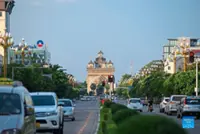Provincial authorities carry one of the Buddha statues from the excavation site. -- Photo Bokeo Provincial Television
VIENTIANE: Another 32 Buddha images and six heads of Buddha images were excavated in Tonpheung district, Bokeo province, on Tuesday (March 19), with the search for more still continuing.
Most of the statuettes appear to be in perfect condition, and are believed to date back to the time when a town named Souvanna Khomkham occupied the site, Deputy Minister of Information, Culture, and Tourism Phosy Keomanivong said on his Facebook page.
Officials involved in the ongoing search for other artefacts at the site could not be reached for comment.
The excavations began on March 14, with 38 Buddha images being found during digs that took place from March 16-18.
Based on a recommendation from the provincial administration office and experts at the Heritage Department of the Ministry of Information, Culture and Tourism, provincial authorities carried out a search for buried artefacts near the Mekong River at a location close to Done Phuengkham island.
All of the images and other items unearthed during the excavation will be registered, according to the Heritage Department.
The age and origin of the Buddha images is unclear but most are made of bronze. They have all been taken to Thongthip Phatthanaram temple in Yaitonpheung village, Tonpheung district, for safekeeping, where they are being closely guarded.
An official at the Heritage Department, Souliphane Boualaphane, told the Vientiane Times that in the past the area was relatively low as it was located near the river and with the passage of time became covered in sand, so that the figurines were buried.
He did not think the images were deliberately buried during wartime, but if they were previously kept in a cave or cliff face, it is possible they were placed there long ago by people hiding from their enemies, he added.
The town of Souvanna Khomkham was destroyed and rebuilt several times by different rulers before it was finally abandoned.
The site still bears the evidence of a former civilisation and the remains of 44 structures made from bricks and sand can be seen, believed to be temples, stupas and statues. These archaeological remains mostly date back to the era when Laos was the Kingdom of Lane Xang, although the town was first established over 1,600 years ago, according to the Lao website www.tourismlaos.org.
However, over the years these have been raided by looters from both Thailand and Laos. One of the most special finds was one of the largest Buddha statues ever to be discovered in Laos or Southeast Asia, measuring 7.10 meters in width with a height of 7.22 metres. Each shoulder is 1.10 metres wide and the distance from the hip to the knee is 3.6 metres.
There are also other structures, which may have been part of the city of Chiang Saen built by the Mekong River during the reign of King Sayyasetthathirat. But the city was destroyed by invading forces from Myanmar and today only traces of its glorious past remain.
The site is preserved for study by students and scientists, and is also a tourist attraction due to the fascination with its mysterious past, according to the Luangnamthatourism.org website. - Vientiane Times/ANN





